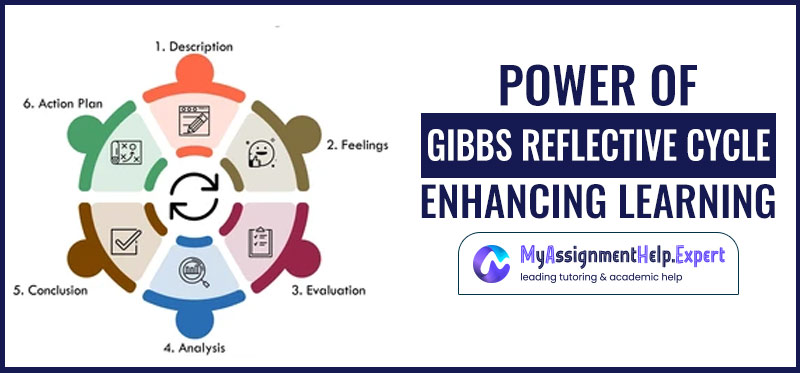Power of Gibbs Reflective Cycle: Enhancing Learning

Reflection is an excellent tool for understanding your motivations, your triggers, your default responses, and any harmful habits you may have. You can get assistance from the Gibbs reflective cycle as you work towards self-awareness and, ultimately self-care.
Graham Gibbs discovered Gibbs’s reflective cycle in 1988. It takes a lot of introspection and self-reflection to develop into a great leader. You may improve as a leader and successfully inspire your team by being aware of your strengths and flaws.
Most of the people discover that experience is the best teacher.
However, it’s difficult for kids to learn anything at all if they don’t think back on their experience and consciously consider how they could perform better the next time.
Gibbs’ Reflective Cycle in nursing is helpful in this situation. You can use it to assist your employees in making sense of workplace circumstances so that they can recognise their strengths and areas for improvement.
What is a Gibbs’ Reflective Cycle?
A well-known reflection model is the Gibbs Reflective Cycle, which provides a structured way for people to think methodically about the experiences they had in a particular setting.
An established and extensively used model of reflection is the Gibbs Reflective Cycle. This Gibbs reflective cycle reference framework was created by Graham Gibbs in 1988 at Oxford Polytechnic, which is now Oxford Brookes University. It is widely used in many industries, such as management, healthcare, and education. It is used to advance both professional and personal development. Since then, it has developed into a crucial component of reflective practice, enabling people to reflect on their experiences in an organised way.
The cycle has six steps that need to be finished for the reflection to have a clear goal. To explain the event is the first step. The next step is to analyse how this may have been handled differently while also examining the knowledge that was gained from the experience, the feelings that were experienced throughout it, and any decisions that were taken in regard to it. The final cycle concludes by developing a strategy for dealing with similar situations in the future.
Why is Gibbs’ Cycle of Reflection Important?
Gibbs’ Cycle of Reflection is significant because it offers individuals with a planned and methodical strategy for reflecting on their experiences and learning. Individuals can better understand their experiences, determine what they have learned, and form a strategy for future actions by going through each stage of the cycle. This can assist in guaranteeing that the reflection process is a continuous process of learning and progress rather than a one-time event.
Gibbs’ Reflective Cycle enables people to think about their own experiences in a more in-depth and analytical approach, which helps them identify ways to improve their practice in the future.
According to a British Journal of Midwifery survey, 63% of healthcare practitioners use Gibbs’ Reflective Cycle as a technique for reflection on a regular basis.
Beverly J. Bowers, an RN, said that – Reflection is an important part of professional nursing practice as well as a tool for learning via practice. This integrative review synthesises the evidence on nursing students’ clinical experience reflection.
This model is useful for processing an experience. This could be a one-time occurrence or something you encounter repeatedly, like meetings with a team you need to work with. Although Gibbs initially recommended using it in repetitive situations, the stages and principles also hold true for one-time events. If the action plan is created for a standalone event, it may become more general and focus on how you may use your conclusions moving forward.
The Six Stages of Gibbs’ Model of Reflection
The Graham Gibbs Reflective Cycle concept is cyclical and has a structure that emphasises repeated experiences. Each of its six levels encourages participation and reflection on a particular learning experience. It is simple to teach in a coaching session using Graham Gibbs’ The Gibbs Reflective Cycle model to analyse a situation and draw conclusions. Graham Gibbs developed a methodology for reflection called the Gibbs Reflective Cycle, which has six stages: description, feelings, evaluation, analysis, conclusion, and action plan.
A list of useful questions is provided below for each stage of the model. You don’t have to respond to all of them, but doing so will help you determine the things that might be appropriate to include at that moment. Other prompts could be more effective for you.
STEP 1: DESCRIPTION
In this reflective practice, people explain the circumstance or their experience as the first step of Graham Gibbs’ Gibbs Reflective Cycle. This is not the time to make judgements; rather, focus on understanding what has happened. The pertinent data that will offer a factual account of the circumstance is the main focus. This phase aids in setting up an appropriate context for comprehending the situation.
Use the following inquiries to learn more about the circumstances described in the Gibbs Reflective Cycle.
- What took place?
- When and where did it occur?
- What brought you there?
- How did you act?
- What actions did others take?
- Who attended?
- What happened in the situation?
- What did you hope would occur?
Example of ‘Description’
My group, which consisted of three other students from my course, and I agreed to divide the various elements amongst us so that we would only have to investigate one component each for an assessed written group work assignment. We didn’t arrange time to sit down and compose the assignment together since we thought we could just piece it together in the afternoon, the day before the deadline. But as soon as we sat down, it became apparent that the portions weren’t written in the same manner. In order to turn the assignment into a coherent piece of work, we were forced to rewrite the majority of it.
We had allotted ourselves enough time before the deadline to write high quality paper writing our respective sections independently, but we had not budgeted a lot of time to rework in case something went wrong. So that the assignment could be completed in time for the deadline, two members of the group had to cancel their evening commitments.
STEP 2: FEELING
The feeling is the second stage of the Gibbs Reflective Cycle. Here, people talk about their feelings and thoughts and how such things have affected their experiences. This stage is designed to help you reflect on the situations and to pose some significant questions to yourself.
- How did you feel before this circumstance?
- How did you feel in this circumstance?
- How do you suppose other people felt in this circumstance?
- How did you feel following this circumstance?
- What do you think about the current circumstances?
- How do you believe that other people will see this current circumstance?
Example of ‘Feelings’
I was happy and believed we had divided the task out wisely before we got together and learned we still had a lot of work to do. I became extremely irritated when we found we couldn’t turn in the assignment as is. I had no drive to actually perform the revising because I was confident it would be successful. Due to the fact that a few group members had to postpone their plans, I found myself feeling pretty guilty, which motivated me to work harder and finish the task earlier in the evening. Looking back, I’m happy we made the effort-related decision.
STEP 3: EVALUATION
The third step of Graham Gibbs’ Reflective Cycle is evaluation. People here review their experience, both positive and negative, of the circumstance. This is the stage at which you must be objective and determine what worked in your favour and what did not.
Use the following questions to learn about the scenarios in the Gibbs Reflective Cycle’s evaluation phase.
- What was a plus in this situation?
- What was wrong with this situation?
- What was successful in this situation?
- What didn’t work out so well in this situation?
- What actions did you take that contributed to this situation? (either positively or adversely)
- What actions did others do that contributed to this situation? (either positively or adversely)
Example of ‘Evaluation’
What was good and worked well was that each group member provided high-quality work by the agreed-upon time. Furthermore, the fact those two members of the group had to cancel arrangements drove us to work harder in the evening. This favourably influenced the group’s work ethic. The fact that we believed we all wrote in the same style clearly did not work, and so the group’s overall time plan failed.
STEP 4: ANALYSIS
The fourth step in Graham Gibbs’ Reflective Cycle is Analysis. In this stage, people think, feel, and try to make sense of what happened. Previously, a person was focused on specifics, but now there is an opportunity to analyse and extract meaning from the circumstance and experience. At this point, anyone who wishes to incorporate academic material may do so. This is the time to figure out what went well, what helped the situation, and what caused the blunder.
Use the following questions to learn more about the circumstances in the Gibbs Reflective Cycle’s analysis section.
- Why did this circumstance go so well?
- Why didn’t things work out in this situation?
- How do you interpret this situation?
- What knowledge can assist in comprehending this situation?
- What other people’s knowledge can assist you in understanding this situation?
Example of ‘Analysis’
I believe our initial task division went well since each person had a choice in whatever part of the assignment they wanted to concentrate on, and we divided based on people’s self-identified strengths. I’ve worked this way previously and noticed that when I’m working alone, I prefer to work in areas that fit my talents. This seems to me to be the case in groups as well.
I believe we assumed that this strategy would save us time when stitching together the portions in the end, and hence, we did not consider it thoroughly. In reality, it took significantly longer than intended, and we had to stress and speed through the rewrite. I believe we got into this predicament because we didn’t plan how we were writing and organising the sections.
STEP 5: CONCLUSION
Conclusion is the fifth step of the Gibbs Reflective Cycle, where people consider what they have learnt and what they could have done differently. This is the section in which you come to conclusions by understanding and concluding what activities could have improved the outcome in the future.
Use the following questions to learn about the situations in the conclusion stage.
- What did I learn from this situation?
- How could it have gone better for everyone?
- What abilities do I need to improve in order to handle similar situations more effectively in the future?
- Is there anything else I could have done to improve this experience?
Example of a ‘Conclusion’
I learned that when a group divides work, we must anticipate how each piece would appear and feel. Doing so would have likely allowed us to put the sections together and submit them without much or any editing. Furthermore, I will continue to ask people to self-identify their skills and may even advise utilising the ‘Belbin team roles’ framework for longer projects. Finally, I learned that we must sometimes challenge the decisions we appear to agree on in the group to make sure that we don’t disagree just due to groupthink.
STEP 6: PLAN OF ACTION
The sixth and last step of the Gibbs Reflective Cycle is the Action plan, in which people express how they will handle similar events in the future and how to do better the next time. This is the time to make changes and devise a strategy for doing things differently in the future.
Use the following questions to learn more about the situations in the action plan stage.
- What would my action plan be, and what would I do differently if I had to do the same thing again?
- How will I acquire the necessary skills to deal with such situations?
- How can I ensure that I will behave differently in such situations in the future?
Advantages and Disadvantages of Reflective Cycle
ADVANTAGES
- It boosts self-esteem through education.
- Encouraging nurses to reflect promotes professional development, which results in better patient care.
- It encourages a comprehensive, individualised, and adaptable approach to care by facilitating the incorporation of theory and practises and generating nursing knowledge.
- It provides a method or technique for nurses to express and confirm the importance of practice and practical knowledge.
- It stimulates critical thinking and assists nurses in making decisions.
DISADVANTAGES
- Psychological tension may be caused through reflective practice.
- Feel frustrated when attempting to tackle difficulties found through reflection.
- Consider unpleasant issues on a regular basis.
- The procedure can be adjusted to achieve the practice’s expected outcomes.
How Does the Gibbs’ Reflective Cycle Help?
Gibbs’ Reflective Cycle provides an organised approach to reflection, making it a useful tool for both educators and students. The methodology promotes critical thinking by boosting the ability to analyse events through questions and turn them into meaningful learning opportunities.
Experiential learning, which is closely related to reflection, proposes that we learn from our experiences, especially when we engage in reflection and active exploration. Gibbs’ approach bridges the gap between theory and practice by providing a framework for meaningfully capturing and analysing experiences.
Educators can use Gibbs’ model to lead students through the reflective process, assisting them in extracting useful lessons from both positive and negative events.
Examples
Gibbs Reflective Cycle is a useful tool for learning and personal development in various stages of life. Here are five hypothetical Gibbs reflective cycle examples:
Nursing
Jane, a nurse, had a difficult interaction with a patient. She started by describing the circumstance and her early responses using the Gibbs Reflective Cycle. She then considered her feelings and noted any unfavourable feelings that had emerged. She identified the need for development in her communication abilities throughout the analytical phase. She came to the conclusion that more effective communication might have produced a better result. She also created a personal growth plan to enhance her communication abilities, highlighting the advantages of in-depth contemplation.
Teaching
Mr. Smith, a teacher, had trouble running his classroom. The Gibbs Reflective Cycle was utilised by him to think back on a particularly stressful day. Through critical analysis, he saw drawbacks in his approach to classroom management and came to the conclusion that he needed to be more explicit with his expectations for his pupils. He subsequently created a strategy to put these adjustments into practice, demonstrating how the reflective process can result in useful advancements.
Customer service
Sarah, a customer service agent, got some helpful criticism from a client who wasn’t happy with the service. She examined the conversation using the Gibbs Reflective Cycle, identifying her dissatisfaction and determining what went wrong. She came to the conclusion that she needed to increase her problem-solving abilities and create a strategy to accomplish this.
Management
Tom, a manager, had trouble assigning responsibilities to his staff. He reflected on a project that took longer than it should have because he was reluctant to delegate using the Gibbs Reflective Cycle. He recognised the negative emotion of his fear of losing control and the necessity of trusting his team during the analysis stage. He subsequently devised a strategy for using delegation in subsequent projects.
Counselling
Dr. Lee, a counsellor, thought that her most recent meetings with a client had not been fruitful. She reviewed these sessions using the Gibbs Reflective Cycle. After identifying her frustration, she realised she needed to modify her counselling methods to meet her client’s requirements better. She then created a strategy to put into action.
These examples show how the Gibbs Reflective Cycle may support learning and reflection in various professions, fostering both personal and professional development.
ON A PARTING NOTE
The Gibbs reflective cycle for nursing in Australia has been utilised frequently in various circumstances to enhance knowledge of a circumstance or event to help individuals learn. The method is regarded as a useful tool that works well with various situations and aids participants in reflecting on a specific situation, understanding it, and drawing conclusions about how to proceed in the future.
Frequently Asked Questions
What is the Gibbs Reflective Cycle, and how does it assist in the process of self-reflection?
The Gibbs Reflective Cycle is a structured framework used for self-reflection in various fields, including education and healthcare. It consists of six stages: Description, Feelings, Evaluation, Analysis, Conclusion, and Action Plan. By guiding individuals to explore their experiences, emotions, and lessons learned systematically it helps foster deeper insights and continuous improvement in professional and personal growth.
How many stages are involved in the Gibbs Reflective Cycle, and could you provide a brief overview of each stage?
The Gibbs Reflective Cycle comprises six stages:
- Description: Start by providing an unbiased account of the event.
- Feelings: Record your feelings regarding the experience.
- Evaluation: Analyse the positive and negative facets of the encounter.
- Analysis: Explore the reasons for how events transpired in greater detail.
- Conclusions: Decide what you could have done differently and what you learned.
- Action plan: Create a strategy outlining what you’ll do in the event that a circumstance like this recurs in the future.
What are the key benefits of using the Gibbs Reflective Cycle in a professional or educational context?
The Gibbs Reflective Cycle offers several benefits in professional and educational contexts.
- Structured self-reflection: Helps organise thoughts and experiences.
- Enhanced learning: Promotes deeper understanding of experiences and lessons.
- Improved problem-solving: Encourages critical analysis and identifying areas for improvement.
- Professional growth: Facilitates continuous development and better decision-making.
- Self-awareness: Enables recognition of emotions and their impact on actions.
- Goal-oriented: Guides the creation of action plans for future situations.
Can you explain how the Gibbs Reflective Cycle differs from other models of reflection commonly used in various fields?
The Gibbs Reflective Cycle stands out due to its systematic approach involving six distinct stages. Unlike some other models, it emphasises a comprehensive exploration of feelings, evaluations, and actions. Other models may vary in the number and arrangement of stages, focusing on different aspects of reflection. The Gibbs model’s structure aids in in-depth analysis and planning, making it particularly suitable for educational and professional contexts.
How can the Gibbs Reflective Cycle be effectively applied in healthcare settings to enhance learning from practical experiences?
In healthcare, the Gibbs Reflective Cycle can be applied effectively by clinicians and students to learn from practical experiences:
- Description: Recall the patient interaction or clinical event.
- Feelings: Explore emotions and reactions, fostering empathy.
- Evaluation: Analyse what went well and the challenges faced.
- Analysis: Examine reasons behind actions, considering theories and guidelines.
- Conclusion: Draw insights into personal and professional growth.
- Action Plan: Develop strategies for future patient care, integrating lessons learned.
This process promotes improved patient care, self-awareness, and continuous development in healthcare professionals.






